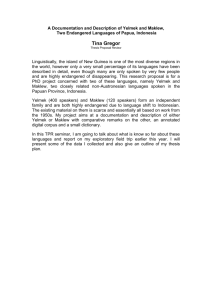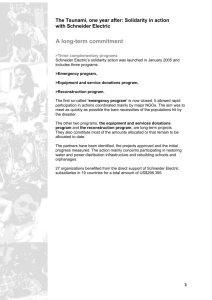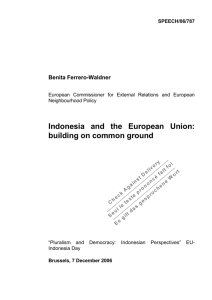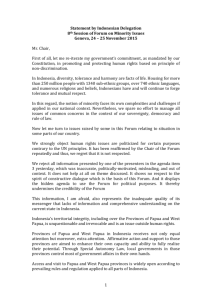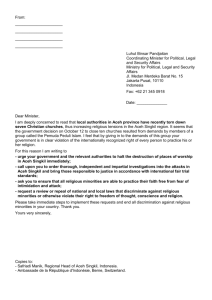PEACE BUILDING IN INDONESIA: BETWEEN THE PAST AND THE
advertisement
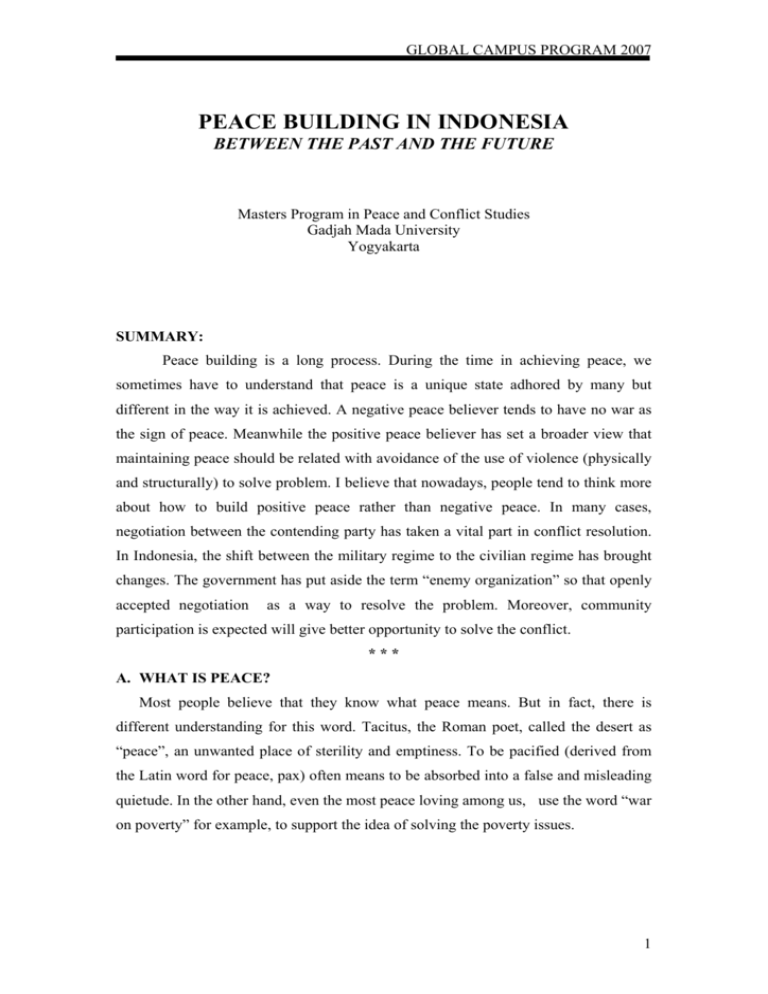
GLOBAL CAMPUS PROGRAM 2007 PEACE BUILDING IN INDONESIA BETWEEN THE PAST AND THE FUTURE Laksana Widitama Masters Program in Peace and Conflict Studies Gadjah Mada University Yogyakarta SUMMARY: Peace building is a long process. During the time in achieving peace, we sometimes have to understand that peace is a unique state adhored by many but different in the way it is achieved. A negative peace believer tends to have no war as the sign of peace. Meanwhile the positive peace believer has set a broader view that maintaining peace should be related with avoidance of the use of violence (physically and structurally) to solve problem. I believe that nowadays, people tend to think more about how to build positive peace rather than negative peace. In many cases, negotiation between the contending party has taken a vital part in conflict resolution. In Indonesia, the shift between the military regime to the civilian regime has brought changes. The government has put aside the term “enemy organization” so that openly accepted negotiation as a way to resolve the problem. Moreover, community participation is expected will give better opportunity to solve the conflict. *** A. WHAT IS PEACE? Most people believe that they know what peace means. But in fact, there is different understanding for this word. Tacitus, the Roman poet, called the desert as “peace”, an unwanted place of sterility and emptiness. To be pacified (derived from the Latin word for peace, pax) often means to be absorbed into a false and misleading quietude. In the other hand, even the most peace loving among us, use the word “war on poverty” for example, to support the idea of solving the poverty issues. 1 GLOBAL CAMPUS PROGRAM 2007 Peace is preferable to war, yet the world has rarely seen a year in recorded history without armed conflict somewhere 1 . This problem occur on the fact that we sometimes forced ourselves to choose understanding peace as a state without conflict or a state of economic, social, and cultural that reduces the possibility of conflict. To me, both understanding only appear to judge whether our peace is a short term type or a long term type. Winning the war may means achieving peace for the short time since there will be chance of retaliation. But reducing the possibility of conflict is also a part of making peace in a long term. B. WHAT KIND OF PEACE DO WE NEED? Since peace can be understood into a state without conflict and as a state with successfully conflict management, I believe that we can’t ignore the concept of negative peace and the positive peace. Negative peace simply denotes the absence of war. Meanwhile, positive peace tend to focus on the fact that conflict as part of human life should be manage well so that there will be no form of violence (both physical and structural violence). 1. NEGATIVE PEACE AS A SHORT TERM PEACE The absence of war becomes crucial for those who believe in negative peace. Some of us may be join the war in order to bring peace. By doing so, it is clear that violence is unavoidable. For those who are seen as the enemy, we may think that it is them who cause the war, it is them who break the peace, and we may think that we are being forced to fight back to defend the peace itself. If we believe with such sentiment, the elimination of enemy is the most important thing. Having no enemy, for some reason, may be seen as having peace. But apart from that, it still hard to ensure that there will be no enemy in the future. People have live for generation with conflict around them. Some conflict may be influence our life less than we care, and some conflicts even tear us apart. That’s why, it is best to say that believing in negative peace means believing in the short term peace. 2. POSITIVE PEACE AS A LONG TERM PEACE 1 Trond Gilberg, “Talking Point –Understanding Conflict” , Global Campus Program discussion paper. 2 GLOBAL CAMPUS PROGRAM 2007 Based on Johan Galtung idea on positive peace, it is clear that violence may appear into both physical and structural violence. The structural violence is typically build into the deepest part of cultural, social and economic institutions. For some reason, structural violence neglected the need and the right such as economic well-being; social, political, and sexual equality; personal fulfillment and self-worth; and so on. Poverty, political repression and psychological alienation as forms of structural violence is often unnoticed and work slowly to degrade humanistic values and impoverish human lives. Since positive peace concerned on violence in a broader perspective, achieving a positive peace means to be prepared to do everything in the long run. Every conflict has potential violence. When the government set a plan to build a factory as example, there will be possibility that the hidden side effect may occur. For the citizen who is not willingly to support the government because he/she believes that there will be no benefit from this plan may protest, or even sabotage the project. And when the situation is getting worse, the use of physical violence is often used. The media usually blow up the incident based on the physical violence that is done by the citizen or done by the government. And there we go again, we beginning to feel insecure at the time. The peace is lost. Well, to me, the problem actually is not only appearing when the physical violence happened, but it can be tracked down before it happened. In Indonesia, one of the problems is rooted on the fact that the citizen participation on development plan is minuscule. It makes the citizen having problem to adjust its interest with the need related with the development plan itself. The rejection of garbage recycle facility plan (TPST / Tempat Pengolahan Sampah Terpadu) in Bojong by the people who life around the future facility as example, has forced many people to think more about difficulties that may appear in waste management 2 . Telling about the benefit of the facility itself, has been 2 WALHI, a NGO with concern on environmental issues in Indonesia, believes that it takes more than Memo of Understanding (MoU) with certain private company to deal with the city dump. Ignorance on the fact that 85% of waste is due to lifestyle, where markets have been deliberately engineered to preserve and maintain a consumptive culture in the community, can not be solved by technology. Indonesia has no history of success in managing waste, and even the sophisticated technology on offer is yet to be proven. To know more about this issue, you may begin with Slamet Daroyni ‘s article “Case Study : Bantar Gebang and Bojong City Dumps” on http://www.eng.walhi.or.id/kampanye/cemar/sampah/bantargeb_cs/ and Khalisah Khalid ‘s “WALHI Jakarta’s General Perspective regarding The Draft Law on Waste Management” http://www.eng.walhi.or.id/kampanye/cemar/sampah/070525_waste_mngmnt_cu/ 3 GLOBAL CAMPUS PROGRAM 2007 proved having less influence to the people. People tend to be satisfied when they are not only know about the plan, but also when they are having the opportunity to participate, to share their idea, related with the management issue such as cost and benefit. C. FROM NEGATIVE PEACE TO POSITIVE PEACE During the rule of Suharto (the 2nd president of Indonesia), most of people in Indonesia, especially who lived in Java Island, felt that peace was in our hands. We didn’t hear any ethnic conflict or any separatism. We also knew that each year the economic condition running without much problem. Stability was the word after peace that most Indonesian knew that day. The fact is, under the rule of Suharto, everything is “under control”. The information is controlled by Information Department (Departemen Penerangan) through certain mechanism such as limitation on the license for publishing newspaper. Kompas, one of the national newspapers in Indonesia as example, once ever lost its rights to publish because kompas has released a sensitive issue related with the government in one of its edition. That’s why; it is not odd to say that this limitation helps Indonesian to feel “peace” at the moment. In my opinion, the condition happened in Suharto era can be seen as an example of negative peace. For those who live in Java, peace was the fact because the conflict in Aceh, the conflict in Papua and the conflict in East Timor were not “exist” in the media. There were no war in Indonesia and everybody lived happily. Of course, for some of my friend who lived in the conflict area such as Aceh, Papua and East Timor will say different thing related this kind of peace. They didn’t feel a peaceful live because they have to live under the suspicion of Indonesia military. Having political reform in 1998 has opened a lot of changes in Indonesia. The media as example has gained its freedom to send the news to the public. This freedom also helps most Indonesian to understand well what is really happening in Indonesia. But the problem is, there is only a few media that able to enlighten the society to understand more about conflict resolution in a more peaceful ways. Most of the news only stops on the fact that violence (both physically and structurally) appear within 4 GLOBAL CAMPUS PROGRAM 2007 the society. These incomplete stories actually tend to make people easily become unsettled by the condition. The Indonesian government mistake in the past, has added a fuel to distrust on certain group in Indonesia. The Papuan as example feels that the central government has been unfair. The fund that allocated into the local government hasn’t fulfilled the need of Papuan. Having PT.Freeport Indonesia, one of the biggest mining company in the world, doesn’t grant a real prosperity for the Papuan. Even though the government under Susilo Bambang Yudhoyono has granted better economic and political access through special autonomy, the distrust toward the government is still appearing 3 . The Indonesian government nowadays learns from the past that military intervention is not always the best tool in dealing with conflict. The problem in Aceh as example has been solved successfully through a peaceful mediation between the Indonesia government and Free Aceh Movement (Gerakan Aceh Merdeka / GAM) on 15th August 2005. The mediation itself is a part of paradigm shifting of the Indonesian government. For years, GAM has been seen as an enemy organization, that’s why it is hard for Indonesia government to think about negotiation as one of the alternative solution. The military intervention has taken place since 1970’s until 2002 and still no peace for Acehnese. D. LEARNING POINT 1. LEARNING FROM THE PAST TO GET THE FUTURE The militaristic regime of Suharto in Indonesia has given enough lessons for us that negative peace is not the real peace in the long term. The worsening relationship among the citizen in Indonesia after his fallen is a proof that a threat from the military is not an effective tool to maintain peace. In Aceh as example, the military operation which is done in order to maintain “peace” by eradicating “the rebellion” has been proved to maintain peace for a short time. The distrust of Aceh people toward Javanese as example has increased based on fact that most of the military personnel who were sent there unfortunately were Javanese. The general bias is the Javanese 3 Sidney Jones articles, “Papua Shrouded by Misperception” on http://www.crisisgroup.org/home/index.cfm?id=4360&l=1 , explained that there were some misperceptions related with Papua. She makes cleared that Papua today is govern by Papuan, Papua is a wash in cash, Independent issue is not the real need for Papuan, and the Indonesian military is not genocidal 5 GLOBAL CAMPUS PROGRAM 2007 (Indonesia) has been colonized Aceh for years and for that reason the Aceh Independent Movement (Gerakan Aceh Merdeka / GAM) has the rights to drive out the Javanese from Aceh apart from the status (civilian or military personnel). Meanwhile, the government in the Suharto era, tend to believe that the military operation which is held there is the best option. In my opinion, the negotiation was impossible at that time because the government set the group as an enemy organization. Fortunately, this mind set finally replaced when Susilo Bambang Yudhoyono took the presidency. After the Tsunami hit Aceh, quickly the government tried to build better relation ship with Aceh people. And finally on 15th August 2005 the dispute between Indonesian government and GAM is resolved. 2. COMMUNITY PARTICIPATION AS A PART OF CONFLICT MANAGEMENT Since positive peace is not simply understood as the absence of war, there will be more thing to do. It is not only related with erasing the physical violence but also minimize the structural violence. To support this idea, I believe that the key is on the word “participation”. When war is declared in a free country, it is up to the citizen to choose joining the war or leave it. The same thing is also happen when we talk about any structural violence such as poverty, you may choose to help eradicating poverty or just ignore it. From the illustration above, it is clear that we can not leave community participation as a part of conflict management. By doing so, it means that we are on the right track on maintaining the positive peace. Papua as one of the conflict area in Indonesia has poverty as the main issues. For some Papuans, independence is seen as an instant solution to solve poverty. But the claim for independent itself is not generally accepted by Papuan since there is no guarantee that the new independent nation-state will be able to bring prosperity. In the Soeharto era, it should be admitted that the central government in Jakarta has enjoyed more economic advantages from Papua more than what it give to Papua. Governmental centralization has proven to be one of the causes of development failure in Papua. The threat of disintegration has influenced the government to shift from centralization to decentralization. Related with Papua, the Indonesia government has adopted a special autonomy for Papua region. The goal of the special autonomy is to give broader opportunity for Papuan to develop based on it’s own need. 6 GLOBAL CAMPUS PROGRAM 2007 The problem is Papuanisation of local government has produces its own problems such as the lack of skilled civil servants and the pull of ethnic and tribal loyalties. More Papuan is beginning to complaint that Jakarta exercises too little control and show less inclination to exert oversight over absentee or corrupt local executive. That’s why to make everything better the central government nowadays has encouraged the civil society to participate more in the development. Having broader participation on development has proved helping the Papua to think more about its potential. The awareness on the “rich forest-poor people” issue as example has encouraged the Governor of Papua Province, Barnabas Suebu, to take the authority on managing the forestry resources to reduce poverty in Papua. Through this progress, I do believe that the war on poverty will not lead Indonesian into the “physical war” because the structural problem has been identified and solved gradually. Bibliography Barash, David P and Charles P Webel. 2002.Peace and Conflict Studies. California : Sage Publication.Inc Ngadisah. 2003. Konflik Pembangunan dan Gerakan Sosial Politik Papua. Yogyakarta : Penerbit Pustaka Raja Barron, Patric et all.23rd august 2005. Konflik dan pemulihan di Aceh : Kajian terhadap dinamika konflik dan Pilihan untuk Mendukung Proses Perdamaian.http://www.conflictanddevelopment.org/data/doc/in/regCaseStud y/aceh/Konflik%20dan%20Pemulihan%20di%20Aceh%20%20ExSum%20Indo.pdf. download on 25th September 2007 Daroyni, Slamet. 3th December 2004. “Case study: Bantar Gebang and Bojong City Dump”. http://www.eng.walhi.or.id/kampanye/cemar/sampah/bantargeb_cs/. Download on 25th September 2007 Jones, Sidney. 29th August 2006. “Papua Shrouded by Misperception”.http://www.crisisgroup.org/home/index.cfm?id=4360&l=1 . download on 25th September 2007 Khalid, Khalisah. 25th May 2007. “WALHI Jakarta’s General Perspective regarding the Draft Law on Waste Management”. http://www.eng.walhi.or.id/kampanye/cemar/sampah/070525_waste_mngmnt _cu/ .Download on 25th September 2007 Global Campus Program discussion articles 2007 7
